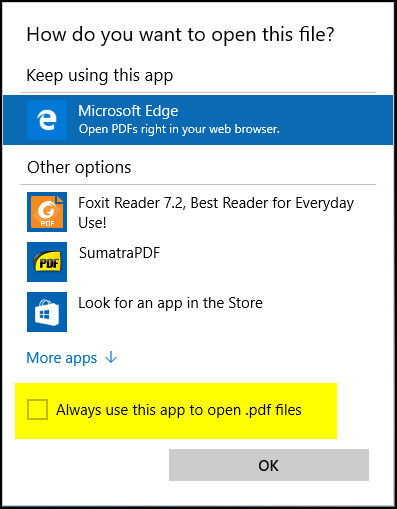
- SET PDF DEFAULT PROGRAM WINDOWS 10 UPDATE
- SET PDF DEFAULT PROGRAM WINDOWS 10 WINDOWS 10
- SET PDF DEFAULT PROGRAM WINDOWS 10 PRO
- SET PDF DEFAULT PROGRAM WINDOWS 10 PC
- SET PDF DEFAULT PROGRAM WINDOWS 10 DOWNLOAD
HKEY_CURRENT_USER\SOFTWARE\Classes\LocalSettings\Software\Microsoft\Windows\CurrentVersion\AppModel\Repository\Packages Proceed through each branch in the name to reach the key indicated. Look for the second branch in the name (in the below case, SOFTWARE) and click the > to expand that branch. This expands the branch and displays other branches to be selected.

Click the > the left of the first branch listed in the name such as the > to the left of HKEY CURRENT USER.
SET PDF DEFAULT PROGRAM WINDOWS 10 PRO
the Registries for Home and Pro differ quite a bit). This means if at any point the instructions or steps don’t match what you see in your Registry, then stop and change nothing….you are in the wrong place in the Registry or the instructions you are following are not for your Registry (i.e. With every Registry edit goes the “warning” that messing with the registry can cause problems. Not sure of your Registry knowledge so I’ll explain the steps in detail. This Registry hack will remove the file association for pdfs from Edge, thus preventing Edge from hijacking pdf file association which will leave the pdf file association to the app you have selected as default for this file type. On my system the pdfs are staying associated with the app I want, Chrome. Sorry to hear that did not keep your pdfs from being taken over by Edge. I’m offering my seaside property in Arizona to anyone who believes that! Then, maybe…just maybe…Win 11 won’t do that. The only solution seems to be for folks like Susan and other credible individuals known to the bandits at Microsoft to continue raising a stink. It seems clear that Microsoft has no intention of allowing anything but Edge to be the default PDF viewer. Here’s what else doesn’t keep Edge from hijacking PDFs: Uninstalling Edge (it pops back up) Changing the default PDF app from Edge to something else, no matter how you do it disabling Edge in Task Manager. AND, changing that setting in Edge didn’t keep Edge from taking over default position for PDFs. Firefox popped up the save dialog instead of opening.
SET PDF DEFAULT PROGRAM WINDOWS 10 DOWNLOAD
The setting you refer to in the Edge settings says this: “If Microsoft Edge is your default PDF reader, PDF files will open automatically without downloading.” Changing that in the settings simply causes the PDF files to download no matter what browser you’re in. Sorry, DrCard, your suggestion did not work.
SET PDF DEFAULT PROGRAM WINDOWS 10 UPDATE
You also have to reapply the changes after every Windows update as the updates will reset them back to Microsoft’s preferred programs (I have mine set to auto-run Set User FTA at every bootup.)

There is a work around that allows you to set your own personal file associations just as before, but it requires 3rd party S/W ( Set User FTA) that can create a “ valid” hash key for the changes so they stick.
SET PDF DEFAULT PROGRAM WINDOWS 10 WINDOWS 10
Prior to Windows 10 you could “ manually” edit the file association entries in the registry to fix your problem but, starting with Windows 10, Microsoft locked them down by using a “ self-generated” hash key that, if changed, forces the file associations to revert back to Microsoft’s preferred defaults.
SET PDF DEFAULT PROGRAM WINDOWS 10 PC
I got sucked into the Microsoft world back in ’92 while serving in the USAF where I had to use Windows for Workgroups 3.11 with the NCSA Mosiac browser.įinally took the plunge and purchased a Windows PC back in ’97 (Gateway laptop) and haven’t looked back since. I started out with an Apple+ and still “ occasionally” used an Apple IIGS all the way up til 2014. Welcome to a fellow Apple devotee who eventually entered the “ convoluted” world of Microsoft Windows! Long gone are the days when system settings and program preferences resided at one location. Since my days of the Apple IIe, through several Macintosh versions, and subsequent entry into the maze that is Windows computing, the PC has pretty much ceased to be “personal,” and has become the CC - Communal Computer.


 0 kommentar(er)
0 kommentar(er)
